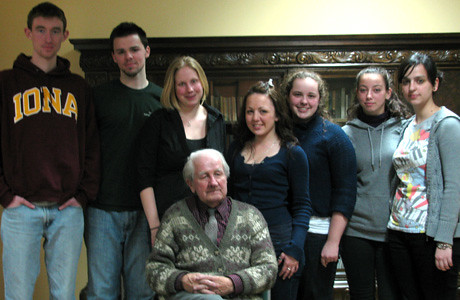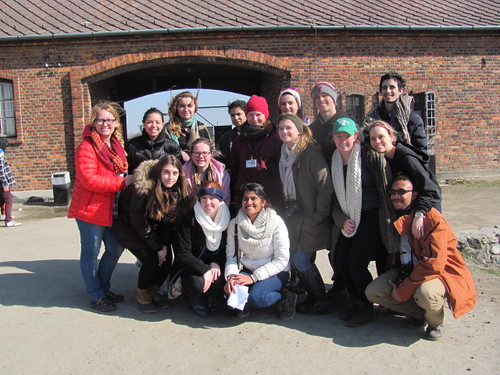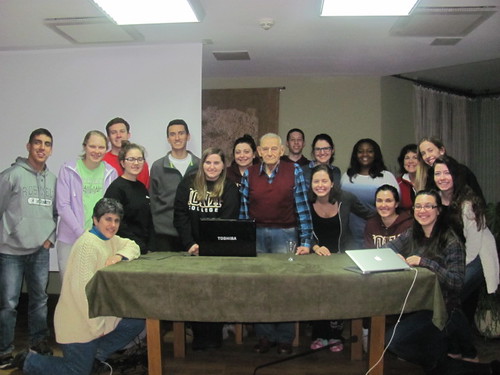My feet led the way. The air was thick. We walked through
the museum sections of Auschwitz that I spoke about in my last blog. These
spots made me think. They put a face to the six million people murdered.
Those spots are easier to describe. I could tell you about
the showcases and what information I learned about them from our tour guide,
Aggy. But trying to explain the other places in Auschwitz is much harder.
These other places are the spots that give off the spirit of
the people who passed.
Rudolf Hess was commandant of Auschwitz. Father Manfred,
director of education at the Center for Dialogue and Prayer, told us about Hess
the night before in class. Fr. Manfred wrote a book on Hess and the
autobiography Hess wrote. I bought Fr. Manfred’s book called, “And Your Conscience
Never Haunted you?” (The book cost 55 zlotys which seemed like a lot but that’s
actually only about $14!)
Aggy took us out of the camp. We went through two sets of
barbed wire fences up to a hill with a chimney coming out of it. Then if you
looked to the far right, you see a big white house. In between the two
was a hanging post. The left was the crematorium, the right was Hess’s home and
right in the middle was where Hess was hanged after he was found guilty in 1947 for
killing 1.5 million Jews.
The killing centers needed to be outside of the camp away from the prisoners to keep them from panic and uprise.
The killing centers needed to be outside of the camp away from the prisoners to keep them from panic and uprise.
After that, we went into the gas chamber. Usually, the killing center was comprised of a changing room, the gas chamber, and the crematorium. However, this set up was a little different because they used buildings that were already constructed and redesigned the insides of them to fit the camp's needs. There was no changing room and it was half above the ground.
I was one of the first people behind my tour guide. My feet just walked in her path. The room was made up of cement walls and it was not that big. There was a small opening in the ceiling where they would put the toxin in. My tears started flowing automatically. My chest felt tight and it was pretty hard to breathe. I looked to the left and saw the ovens through the doorway. At that point, I was hysterical. I walked in, looked around, and got out as soon as I could. It wasn’t the image of the ovens that put me into shock but the presence that affected my whole body.
I felt the same emotions looking at the hanging post. Looking at the wood post with the hook on the end, I felt like I saw a quick, blurry imagine of a man who was hung. In the crematorium, I could see the Jews placing the corpses in the ovens one by one. The smells. The ashes. The heat. In the gas chambers, I could imagine the claustrophobia. The screams. The gas. The bodies falling on the ground one by one.
I walked back into the fresh air. The air was light again and I could control my sobbing a little better. My mind was racing and thousands of emotions were running through my body. Aggy gave us a couple of minutes to reflect and catch our breaths. Then she started leading us to another location. I was walking behind Luis and as he tries to walk around something, I see a little girl on the ground.
The little girl with brown hair was playing with the rocks from the ground.
Innocence.
I thought back to the tour guide saying the statistic that one out of the four people who were killed in the gas chambers was a child. Most of the children did not even get registered in the camp. They were sent right to the gas chambers. The images in my mind went back to the videos from various documentaries we watched. There was always someone talking about the selection process. With tears rolling down their face, they talk about when they were ripped away from their families. I could not see this girl’s parents anywhere.
During group reflection, everyone spoke about how he or she saw the little girl and how she gave him or her hope. Hope that there is still good in the world. Hope that there is still innocence. My classmates also reminded me that the children who were gassed, were saved from having their innocence stripped away from them. Death was their freedom from the emotional torture and starvation they would have faced. God saved them with eternal life and they are safe in His hands.
Unfortunately the tour did not end there.
We went to Block 11 – the first administrative center and camp prison. This was the place where prisoners were held on trial without a lawyer and then punished/held there until they were killed. We saw examples of living quarters for the prisoners and an office for the SS guard. The worst part of this building was the basement.
Down there, we saw the starvation, standing, and suffocation cells. Each cell was like a dark closet that you are too afraid to look into. First, we saw the starvation cell where Father Maximillion Kolbe stayed for 2 weeks until he was killed by the SS guards. The Nazis assumed that he would have died from hunger and it was a miracle that he survived for as long as he did without food. Kolbe was in the starvation cell because he switched spots with another man who was in trouble. The other man survived the war because Kolbe sacrificed his life for him. Pope John Paul II visited Kolbe's cell and canonized him in 1980.
I left Auschwitz I emotionally and physically drained. My upper back was in pain and I needed a nap desperately. I am going back on Thursday morning for class. I am nervous for all of the emotions to come back. However, I know that all of these experiences at the camps will help me deepen my faith.



























